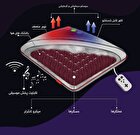Unveiling Mysteries of Electron Tunneling

Using a van der Waals complex, Ar-Kr+, and an innovative approach for tracking tunneling dynamics, the research highlights the crucial influence of neighboring atoms in quantum tunneling. This work has important implications for quantum physics, nanoelectronics, and the study of complex biomolecules, the journal Light: Science & Applications reported.
Tunneling is a fundamental process in quantum mechanics, involving the ability of a wave packet to cross an energy barrier that would be impossible to overcome by classical means. At the atomic level, this tunneling phenomenon significantly influences molecular biology. It aids in speeding up enzyme reactions, causes spontaneous DNA mutations, and initiates the sequences of events that lead to the sense of smell.
Photoelectron tunneling is a key process in light-induced chemical reactions, charge and energy transfer, and radiation emission. The size of optoelectronic chips and other devices has been close to the sub-nanometer atomic scale, and the quantum tunneling effects between different channels would be significantly enhanced.
The real-time imaging of electron tunneling dynamics in complex has important scientific significance for promoting the development of tunneling transistors and ultrafast optoelectronic devices. The effect of neighboring atoms on electron tunneling dynamics in the complex is one of the key scientific issues in the fields of quantum physics, quantum chemistry, nanoelectronics, etc.
In a new paper published in Light Science & Application, a team of scientists from Hainan University and East China Normal University designed a van der Waals complex Ar-Kr+ as a prototype system with an internuclear distance of 0.39 nm to track the electron tunneling via the neighboring atom in the system of sub-nanometer scale.
The intrinsic electron localization of the highest occupied molecular orbital of Ar-Kr gives a preference for electron removal from the Kr site in the first ionization step. The site-assisted electron-hole in Ar-Kr+ guarantees that the second electron is mainly removed from the Ar atom in the second ionization step, where the electron may straightly tunnel to the continuum from the Ar atom or alternatively via the neighboring Kr+ ionic core.
In combination with the improved Coulomb-corrected strong-field approximation (ICCSFA) method developed by the team, which is able to take into account the Coulomb interaction under the potential during tunneling, and by monitoring the photoelectron transverse momentum distribution to track the tunneling dynamics, then, it was discovered that there are two effects of strong capture and weak capture of tunneling electrons by a neighboring atom.
This work successfully reveals the critical role of neighboring atoms in electron tunneling in sub-nanometer complex systems. This discovery provides a new way to deeply understand the key role of the Coulomb effect under the potential barrier in the electron tunneling dynamics, solid high harmonics generation, and lays a solid research foundation for probing and controlling the tunneling dynamics of complex biomolecules.
4155/v
























